Lower back pain can interfere with your day-to-day life on a major basis. If you’re constantly in pain, it might decrease your focus, increase your stress, and make it difficult to enjoy your hobbies.
Many people work jobs that require long periods of sitting. That can seem to exacerbate lower back pain, especially if you can’t often exercise. These are some tips for how to sit with lower back pain so that you don’t worsen your condition. If you sit in the right position, you can reduce the pain by removing pressure on the muscles and nerves in your lower back.
Depending on the situation, you might be able to improve your back pain during other periods of your life, too. First and foremost, angles matter. More specifically, you need to pay attention to the angle of your back and knee parallel to the floor. If your back is at the wrong angle, it will increase low back pain.
Have you ever heard that sitting up straight is best for your posture? That’s actually not true. For people with back pain, it’s better to lean back at an angle. A chair angle of 100 degrees is the minimum, and some people choose to sit at a 110 degree angle or more. Doing this reduces pressure against your spinal discs.
In addition, a straight backrest might make you slouch in your chair. That will definitely worsen your back pain. Hunching and slouching increases the weight on your muscles, and it compresses your spinal cord so your nerves can’t function properly. Research indicates that people experience the most relief when reclining at a 135 degree angle.
But this isn’t easy to maintain when you’re working a desk job. Doing so makes it difficult to see your screen or type on your keyboard. While you’re on breaks from work, though, consider leaning your chair back to 135 degrees. The angle of your knee makes a difference because it affects the posture of your lower body.
These are some good rules of thumb:
- Don’t cross your legs, especially if you have sciatica
- Your knees should be bent at about 90 degrees
- Plant both feet on the floor, using a footrest if your legs aren’t long enough
Doing this keeps the body in a neutral stance that prevents your muscles from being strained.
Other Considerations When Sitting
In addition to the angle of your body, you can also reduce your lower back pain by having the right support. With low back pain, lumbar support is key. This type of support helps to keep the lower back muscles curved naturally, so pressure doesn’t build against the spine. Not everyone will need more lumbar support, but if you do, it makes a big difference. You can do a quick test to see if your chair needs lumbar support. Sit down and press your hips against the back of the chair. If your lower back isn’t pressed to the chair back and is instead curved forward, then lumbar support is essential.
Another important note is that you should change your sitting positions regularly throughout the day. For people with back pain, sitting in the same position all day can lead to muscle stiffness, soreness, and inflammation. You need to change your body position regularly so that your muscles aren’t overworked or underworked. There are three sitting positions that work well for low back pain.
These neutral poses all keep pressure and weight from building up in the lower back muscles. The easiest position to use is reclined sitting. This position is as described above – the back at 110 degrees and the knees at 90 degrees, feet flat on the floor. Of the three positions, this one causes the least amount of muscle activity in the back. During breaks, you can recline further.
The next position is called the declined position. With this one, your body is angled forward. Your back is straight, and your arms rest on top of your desk. Instead of your knee being at 90 degrees, your legs are angled down. This allows you to keep your natural lumbar curve in place, which reduces fatigue over time.
The last position is the supine position. It is achieved by lying down almost horizontally as you work. This allows the majority of your body to be supported by the mattress, couch, or floor. To learn more about how to reduce your low back pain, call us at 205-637-1363.







